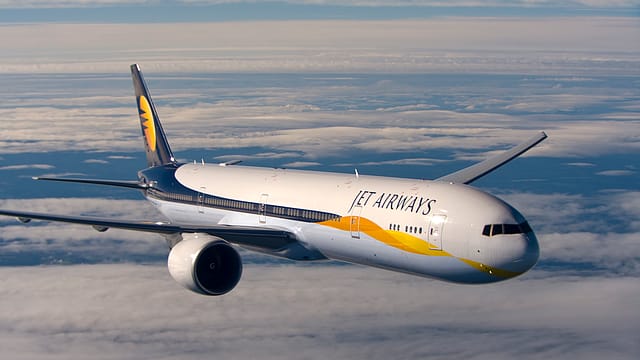Jet Airways posts Rs 1,326 crore loss in June quarter
ADVERTISEMENT

Crisis-ridden Jet Airways plans to implement several cost-reduction measures in a bid to reduce costs by Rs 2,000 crore in the next two years.
Jet Airways on Monday posted a net loss of Rs 1,326 crore for the quarter ended June 2018 due to higher fuel costs, competitive fares and a falling rupee. The carrier had posted a profit of Rs 58 crore in the corresponding period last year. However, for the full financial year FY18, it reported a net loss of Rs 1,040 crore.
“Rise in Brent fuel prices, a depreciating rupee, and the resulting mismatch between high fuel prices, and low fares have adversely impacted the Indian aviation industry, including Jet Airways”, said Jet Airways’ chief executive Vinay Dubey.
Earlier this month the airline deferred announcing its first quarter results because the auditors did not “recommend” the financial results in the annual general meeting.
Apart from cost rationalisation, the company’s management also aims to increase its revenue per available seat-kilometer (RASK) by at least 3-4% by reworking on its network, pricing, inventory management, and sales strategies. The airline has also decided to provide choices and flexibility to its customers for their products and services --- very similar to Vistara’s strategy.
January 2026
Netflix, which has been in India for a decade, has successfully struck a balance between high-class premium content and pricing that attracts a range of customers. Find out how the U.S. streaming giant evolved in India, plus an exclusive interview with CEO Ted Sarandos. Also read about the Best Investments for 2026, and how rising growth and easing inflation will come in handy for finance minister Nirmala Sitharaman as she prepares Budget 2026.
The carrier also wants to restructure its balance sheet and will look at different recapitalisation options while rationalising its aircraft fleet through wet leasing its excess ATRs and simplifying the sub-fleet of B737s to improve bottom line.
Wet leasing of aircraft is an arrangement wherein an airline will provide its complete crew, maintenance, and insurance along with the aircraft to the other party that leases the aircraft.
“We are implementing a host of measures to reduce costs and increase revenue, while retaining our focus on our guests,” said Dubey.
The carrier’s gulf partner, Etihad Airways, too, reiterated its confidence in the carrier and said it “remains committed to the strategic partnership with the airline” as it continues to leverage the opportunities in the growing Indian aviation market.
While analysts have welcomed the management’s decision to work on a turnaround plan, they still have reservations about the plan. “It is the right step. The carrier is laden with huge debts and interests. How do they plan to raise funds? And, when the airline is in such precarious condition, what are the terms and conditions? This is something they need to see,” said an analyst on condition of anonymity.
Expressing concerns over the cost rationalisation measures, employees said that they were expecting lay-offs and pay cuts as a part of the turnaround plan. “The company has done it before and they may do it again. We expect them to explain their plan in detail,” said an employee on condition of anonymity.
Earlier this month the carrier had asked its employees to take a pay cut of up to 25% from August in a bid to trim its operating costs. However, it rolled back its decision to cut salaries under pressure ahead of its quarterly results that was supposed to be announced on August 9.
The company said it aims reduce non-fuel cost by 12-15% in the next 8-10 quarters. Employee cost was a significant expense for the company --- Rs 3,000 crore in FY18, an increase of 3.6% over last year. The carrier has the highest cost structure among private carriers
